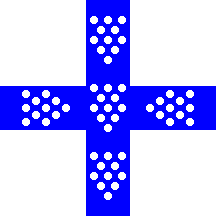
Last modified: 2009-09-12 by antónio martins
Keywords: afonso henriques | cross (blue) |
Links: FOTW homepage |
search |
disclaimer and copyright |
write us |
mirrors

This is the heraldic banner of King Afonso Henriques, a blue cross
on a silver background.
António Martins, 21 May 1997
The blue cross on white of the portuguese arms (bezanted in 1143 and broken into eschuteons in 1185) is also said to have apeared from heaven to king Afonso Henriques during the battle of Ourique, in 1139 (note the date inconsistency!). This legend (among many others) was popularized by romanticizing 16th cent. authors (and later), grossly overestimating the importance of the battle (wich is not even mentioned in contemporary arab documents and only briefly, as a minor squermish, in christian records) and by placing it in nowadays Ourique town and municipality (more than 200 km south of the reconquista border of the time (!); most likely, it happend in other Ourique, a village in Cartaxo municipality). Similar nonsence about the meaning of the five sets of five bezants (as the 30 coins of Judas, or the five moor kings from Sevile, Badajoz, Elvas, Evora and Beja, all deafeted in the battle) was also spreaded by the sames sources...
Naturally the apocriphity of this legend is proven also on pure heraldic and vexillological grounds, not only historical: It is widely known that the number of bezants was fixed much later, only in 1578, and that the blue cross on white was Count Henrique’s personal coat of arms — which was inherited by his son, as Count, and later (first) King, of Portugal.
António Martins, 19 Oct 1998
The Grande Enciclopédia Portuguesa e Brasileira shows
this flag with the cross not touching the flag borders (like
Switzerland). In any case it is a reconstruction
of a supposed flag.
Mario Fabretto, 22 May 1997
Yes — that vexillological error is widely known to be
restricted to that particular source. All other agree about "de
prata cruz firmada de blau", as in my picture. But, being a
reconstruction, maybe everybody is simply perpetuating an error…
On the other hand, crosses stretched till the edge were much more
common these days (and nowadays…).
António Martins, 22 May 1997

So, in the time of Afonso Henriques (1143-1185) it was just a blue
cross semmy of bezants. Only a practical (or maybe aestethical or
mystical-symbolic) reason could account for the positioning of those
silver nails in five distinct areas. Later, when Afonso Henriques
died, the old shield (which, out of battle proudness, was not repaired
in those days) had lost all of the blue cross material (dyed leather),
remainning only attached the parts covered with the nails. Hence the
eschuteons…
António Martins, 08 Oct 1998
Anything below this line was not added by the editor of this page.